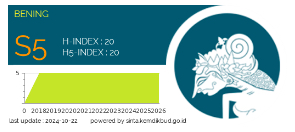PENGARUH ENTREPRENUERIAL ORIENTATION DAN KAPABILITAS INOVASI TERHADAP KINERJA ORGANISASI: STUDI EMPIRIK PADA UKM KOTA SORONG
Abstract
Keywords
Full Text:
PDFReferences
ALI, H., HAO, Y., & AIJUAN, C. (2020). Innovation Capabilities and Small and Medium Enterprises’ Performance: An Exploratory Study. Journal of Asian Finance, Economics and Business, 7(10). https://doi.org/10.13106/jafeb.2020.vol7.no10.959
Barney, J. (1991). Barney, J. (1991). Firm Resources and Sustained Competitive Advantage. Journal of Management, 17(1), 99–120. http://doi.org/10.1177/014920639101700108Firm Resources and Sustained Competitive Advantage. In Journal of Management (Vol. 17, Issue 1).
Barney, J. B. (2000). Firm resources and sustained competitive advantage. Advances in Strategic Management, 17. https://doi.org/10.1016/S0742-3322(00)17018-4
Barney, J. B. (2015). Economics Meets Sociology in Strategic Management Firm resources and sustained competitive advantage Article information. Economics Meets Sociology in Strategic Management, 17.
Barney, J. B., Ketchen, D. J., & Wright, M. (2021). Resource-Based Theory and the Value Creation Framework. Journal of Management, 47(7). https://doi.org/10.1177/01492063211021655
Bodlaj, M., Kadic-Maglajlic, S., & Vida, I. (2020). Disentangling the impact of different innovation types, financial constraints and geographic diversification on SMEs’ export growth. Journal of Business Research, 108. https://doi.org/10.1016/j.jbusres.2018.10.043
Carrasco-Carvajal, O., & Garciá-Pérez-De-Lema, D. (2021). Innovation capability and open innovation and its impact on performance in smes: An empirical study in chile. International Journal of Innovation Management, 25(4). https://doi.org/10.1142/S1363919621500390
Chinakidzwa, M., & Phiri, M. (2020). Impact of digital marketing capabilities on market performance of small to medium enterprise agro-processors in Harare, Zimbabwe. Business: Theory and Practice, 21(2). https://doi.org/10.3846/btp.2020.12149
Cillo, P., de Luca, L. M., & Troilo, G. (2010). Market information approaches, product innovativeness, and firm performance: An empirical study in the fashion industry. Research Policy, 39(9). https://doi.org/10.1016/j.respol.2010.06.004
Covin, J. G., & Wales, W. J. (2012). The Measurement of Entrepreneurial Orientation. Entrepreneurship: Theory and Practice. https://doi.org/10.1111/j.1540-6520.2010.00432.x
Covin, J. G., & Wales, W. J. (2019). Crafting High-Impact Entrepreneurial Orientation Research: Some Suggested Guidelines. In Entrepreneurship: Theory and Practice (Vol. 43, Issue 1). https://doi.org/10.1177/1042258718773181
Drucker, P. F. (2017). The Practice Of Management. In Modern Economic Classics-Evaluations Through Time. https://doi.org/10.4324/9781315270548-23
Ethiraj, S. K., Gambardella, A., & Helfat, C. E. (2018). Theory in strategic management. In Strategic Management Journal (Vol. 39, Issue 6). https://doi.org/10.1002/smj.2796
Ferdinand, A. (2011). Metode Penelitian Manajemen Pedoman Penelitian untuk Penulisan Skripsi Tesis dan disertai Ilmu Manajemen. In Semarang: Universitas Diponegoro.
Foss, N. J., & Hallberg, N. L. (2014). How symmetrical assumptions advance strategic management research. In Strategic Management Journal (Vol. 35, Issue 6). https://doi.org/10.1002/smj.2130
Hair, J. F.; Black, W. C.; Babin, B. J.; Anderson, R. E. (2014). Multivariate Data Analysis. In Statistica Neerlandica. https://doi.org/10.1111/j.1467-9574.1962.tb01184.x
Hernández-Perlines, F., Covin, J. G., & Ribeiro-Soriano, D. E. (2021). Entrepreneurial orientation, concern for socioemotional wealth preservation, and family firm performance. Journal of Business Research, 126. https://doi.org/10.1016/j.jbusres.2020.12.050
Hitt, M. A., Xu, K., & Carnes, C. M. (2016). Resource based theory in operations management research. Journal of Operations Management, 41. https://doi.org/10.1016/j.jom.2015.11.002
Hoque, A. S. M. M., & Awang, Z. bin. (2019). Does gender difference play moderating role in the relationship between entrepreneurial marketing and bangladeshi SME performance? Accounting, 5(1). https://doi.org/10.5267/j.ac.2018.06.001
Hoque, A. S. M. M., Siddiqui, B. A., Awang, Z., & Baharu, S. M. A. T. (2018). European Journal of Management and Marketing Studies EXPLORATORY FACTOR ANALYSIS OF ENTREPRENEURIAL ORIENTATION IN THE CONTEXT OF BANGLADESHI SMALL AND MEDIUM ENTERPRISES ( SMES ). European Journal of Management and Marketing Studies, 3(2).
Hunt, S. D., & Morgan, R. M. (1995). The Comparative Advantage Theory of Competition. Journal of Marketing, 59(2). https://doi.org/10.1177/002224299505900201
Ibrahim, N. A., & Mas’ud, A. (2016). Moderating role of entrepreneurial orientation on the relationship between entrepreneurial skills, environmental factors and entrepreneurial intention: A PLS approach. Management Science Letters. https://doi.org/10.5267/j.msl.2016.1.005
Kozlenkova, I. v., Samaha, S. A., & Palmatier, R. W. (2014). Resource-based theory in marketing. In Journal of the Academy of Marketing Science (Vol. 42, Issue 1). https://doi.org/10.1007/s11747-013-0336-7
Lee, D. Y., & Tsang, E. W. K. (2001). The effects of entrepreneurial personality, background and network activities on venture growth. Journal of Management Studies, 38(4). https://doi.org/10.1111/1467-6486.00250
Martin, S. L., Javalgi, R. G., & Cavusgil, E. (2017). Marketing capabilities, positional advantage, and performance of born global firms: Contingent effect of ambidextrous innovation. International Business Review, 26(3). https://doi.org/10.1016/j.ibusrev.2016.11.006
Nutt, P. C., Shrivastava, P., Huff, A., & Dutton, J. (1993). Advances in Strategic Management, Vol. 7. Administrative Science Quarterly, 38(2). https://doi.org/10.2307/2393419
O’Cass, A., & Sok, P. (2012). Examining the role of within functional area resource-capability complementarity in achieving customer and product-based performance outcomes. Journal of Strategic Marketing, 20(4). https://doi.org/10.1080/0965254X.2011.643918
Ringle, C. M., Wende, S., & Will, S. (2005). SmartPLS 2.0 (M3) Beta. Hamburg.
Silvia, M., Rajshekhar, J., & Erin, C. (2017). Marketing capabilities, positional advantage, and performance of born global firms: Contingent effect of ambidextrous innovation. International Business Review, 26.
Sok, P., O’Cass, A., & Sok, K. M. (2013). Achieving superior SME performance: Overarching role of marketing, innovation, and learning capabilities. Australasian Marketing Journal, 21(3). https://doi.org/10.1016/j.ausmj.2013.04.001
Wales, W. J., Covin, J. G., & Monsen, E. (2020). Entrepreneurial orientation: The necessity of a multilevel conceptualization. Strategic Entrepreneurship Journal. https://doi.org/10.1002/sej.1344
Yaseen Zeebaree, M. R., & Siron, R. B. (2017). International Review of Management and Marketing The Impact of Entrepreneurial Orientation on Competitive Advantage Moderated by Financing Support in SMEs. International Review of Management and Marketing, 7(1).
DOI: https://doi.org/10.33373/bening.v9i1.3666
Refbacks
- There are currently no refbacks.
ISSN Barcode:

Ciptaan disebarluaskan di bawah Lisensi Creative Commons Atribusi 4.0 Internasional.
 Jurnal Bening
Jurnal Bening













